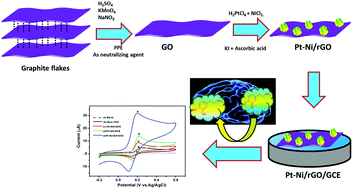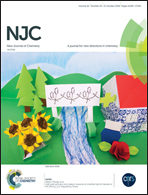Ultrafine Pt–Ni bimetallic nanoparticles anchored on reduced graphene oxide nanocomposites for boosting electrochemical detection of dopamine in biological samples†
Abstract
Pt–Ni bimetallic nanoparticles on the surface of reduced graphene oxide (rGO) nanosheets were prepared by using a wet–reflux strategy and characterized by transmission electron microscopy (TEM), field emission scanning electron microscopy (FE-SEM), Xray diffraction (XRD) and Raman spectroscopy. The glassy carbon electrode modified with Pt–Ni/rGO demonstrated excellent electrochemical activity towards dopamine (DA) in the presence of acetaminophen (APAP) and etilefrine hydrochloride (ET). From the differential pulse voltammetry (DPV) results obtained for the ternary mixture of DA, APAP and ET, the limit of detection (LOD) and limit of quantification (LOQ) of DA were calculated to be 0.0026 μM and 0.00876 μM, respectively. The proposed sensor was successfully employed for the sensing of DA in aqueous solution, pharmaceutical drugs and human serum samples in a mixture with APAP and ET.



 Please wait while we load your content...
Please wait while we load your content...